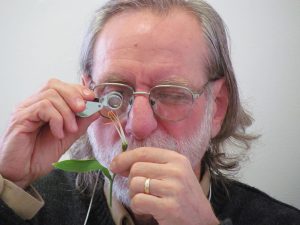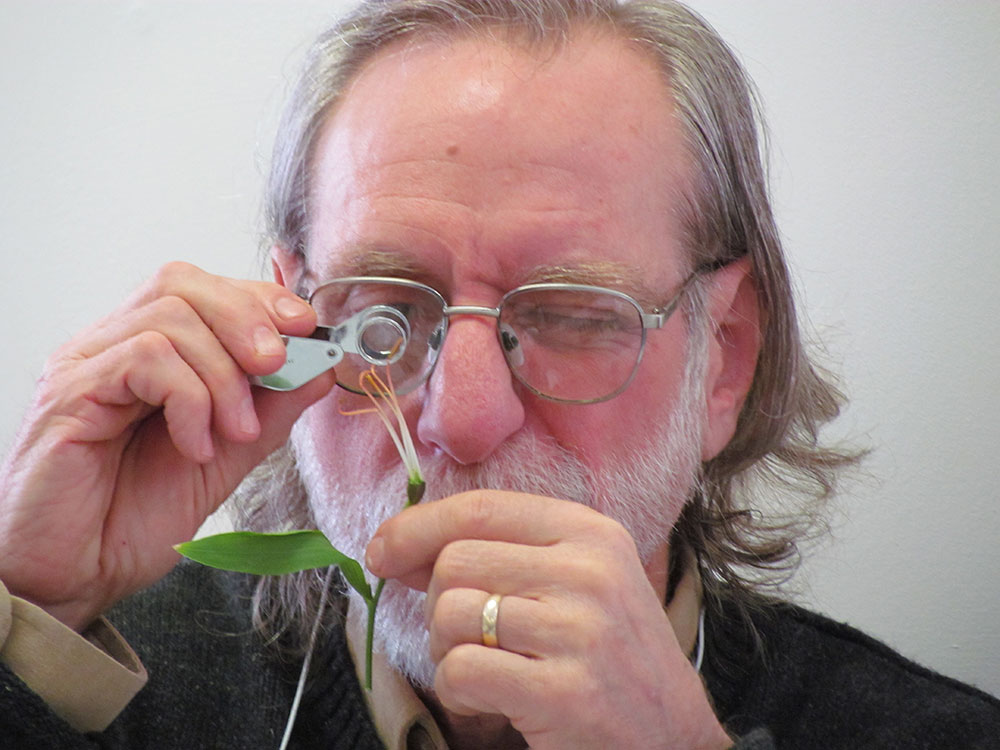
Maine Home Garden News — August 2016
- August Is the Month to . . .
- Sowing Native Seeds
- Staff Favorites: Wildflowers
- Master Gardener Mentors Can Ease the Transition for New Trainees
- Food & Nutrition: New “Choice” Salsa Recipe
August Is the Month to . . .
By Tori Lee Jackson, Associate Professor of Agriculture & Natural Resources, UMaine Extension in Androscoggin and Sagadahoc Counties
- Get more out of your yard and garden by attending a workshop:
- Preserving the Harvest: Tomatoes and Salsa
- Plein Air Painting at Tidewater
- Call your UMaine Extension county office to find out when the next Master Gardener Volunteer training will be offered
- Share the bounty. Learn how gardeners can donate high quality surplus produce to those who have limited access to fresh vegetables: how to donate food to Maine Harvest for Hunger.
- Keep Planting. Prepare your garden for planting garlic this fall. Greens, lettuces, radishes, broccoli, and cauliflower can be harvested up until a hard frost.
- Monitor for Spotted Wing Drosophila if you have summer-ripening fruits. Learn how to make a simple trap.
- Preserve raspberries and other fruits for the winter months by making delicious homemade jam.
- Test your soil! There is never a wrong time to determine what’s going on beneath the surface of your garden. Get results now for planning fall amendments.
- Fix your lawn. Have some trouble spots or interested in reseeding your entire lawn? Mid-August through September is the best time of year to establish new grass. Check out Bulletin #2367, Establishing a Home Lawn in Maine, Bulletin #2243, Maintaining a Home Lawn in Maine and Bulletin #2166, Steps to a Low-Input, Healthy Lawn for tips and step-by-step instructions.
- Apply beneficial nematodes for white grub management.
- Follow these great tips on how and when to harvest a number of crops from the National Garden Bureau. They offer some nice recipes too!
- August is one of the driest months of the year. After an already dry season, be sure to keep your soil moist without over-watering or wasting water with Bulletin #2160, Trickle Irrigation: Using and Conserving Water in the Home Garden. Most crops benefit from having 1 inch of water per week. A rain gauge is a simple and inexpensive tool for monitoring whether mother nature is giving our gardens what they need.
- Attend one of Maine’s Agricultural Fairs. Support local farms and 4-H!
- August 4 – 7: Monmouth Fair at Monmouth, Maine. A small family agricultural fair with midway, animal exhibits, crafts and animal pull events.
- August 9 – 14: Topsham Fair at Topsham, Maine. Agricultural exhibits, animal pull events, 4-H, crafts, midway and harness racing.
- August 11 – 20: Skowhegan State Fair a Skowhegan, Maine. A large agricultural fair featuring a huge midway, animal exhibits, crafts, commercial exhibits, flower show, animal pull events, and harness racing.
- August 24 – 25: Maine Farm Days at Clinton, Maine
- August 20 – 27: Union Fair at Union, Maine. A large family fair famous for the annual State of Maine Wild Blueberry Festival. Large midway, crafts, animal pull events, harness racing.
- August 25 – 28: Piscataquis Valley Fair at Dover-Foxcroft, Maine. Agricultural exhibits, milking parlor, home made ice cream, crafts, midway, mechanical pulling, demo derbies, animal pulling, and stage shows.
- August 25 – 28: Acton Fair at Acton, Maine. Outstanding exhibits, 4-H, livestock exhibit, flower show, animal pull events, midway.
Sowing Native Seeds
By Heather McCargo, Executive Director, Wild Seed Project
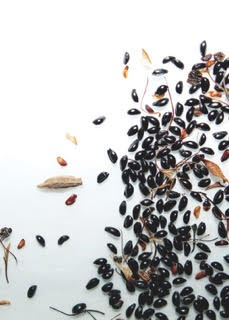
The seeds of wild plants have a different set of needs than those of common garden and vegetable species. Most gardeners think of spring as the time to sow seeds, but for most native plants in Maine fall to early winter is the best time. Many wildflowers, trees and shrubs have seeds that need to experience a winter cold period before they will germinate. Some species also have seeds that must be sown fresh. If these moisture-dependent seeds are allowed to dry out, they will either go into an extended period of dormancy or the seeds will become non-viable. For individuals new to native seed sowing, there are many beautiful native species that are easy to grow from seed, but the specific requirements for successful propagation must be understood to assure success. Fortunately, the methods are simple, and no sophisticated facilities are required as the seeds are ideally suited to germinate outdoors in beds or pots. Seed propagation is also an inexpensive way to produce a lot of plants.
A key benefit of growing native plants from seed is it’s the best way to preserve the genetic diversity within a species. In the wild, most plants reproduce by seed. Seeds develop when flowers are pollinated (usually by insects, sometimes by the wind) mixing the genes of multiple individuals. This results in genetically diverse individuals. This variation is a wild plant’s best strategy to adapting to future environmental conditions as individuals differ in their ability to deal with drought, heat, flooding, cold, and pollution.
Modern horticultural practices have shifted to favoring cloned plants, called cultivars. The traditional way to clone plants is to dig up the plant and divide the root system into multiple pieces, or to take stem cuttings and root them in a misting chamber. Increasingly today many landscape plants are cloned in a laboratory with a process called tissue culture, where cells from a mother plant are cultured in a petri dish and stimulated into growth using a variety of synthetic chemicals — a practice counter to supporting natural plant evolution. With any of these methods, it is just one individual whose genes are being propagated. With a rare species with no ability to reproduce sexually this may be the only solution to perpetuating a species on the verge of extinction. With the rising interest in native plants for gardens and developed landscapes, it is important that we preserve the genetic diversity within our native plants; gardens filled with cloned plants will not have the diversity needed to adapt to the vagaries of a changing environment. For our landscapes to be resilient, it is important that native plants are propagated from seed whenever possible. If a lot of people started sowing native seeds, we could rapidly increase the resiliency of our landscapes and support the genetic diversity of our Maine flora.
There is another often overlooked benefit of outdoor propagation: plant health. Damping off, fungal gnats, aphids, and algae growth — the bane of greenhouse and indoor seed starting — are nearly nonexistent with outdoor propagation. And now with the widespread availability of a good organic compost/aged bark potting mix, it is very easy to produce healthy plants.
My work has focused on native plant propagation and horticulture ever since I worked as the propagator at the Garden in the Woods, the botanic garden of the New England Wildflower Society in Massachusetts. I have grown many different native species, and I am also an experienced organic vegetable and herb grower. In so many ways, I find sowing native seeds much easier, and the plants are beautiful and robust. If you are one of those people who thinks they always fail with seed germination indoors, you may very well find yourself successful with the methods that I have used. Below I will explain how I do it.
Outdoor seed propagation
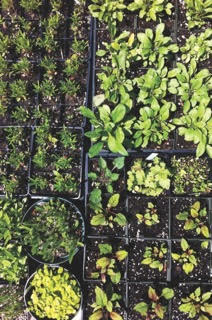
Seeds can be sown in pots or seed flats that are tucked out of the way in a shady location. A dozen 4-inch pots can fit under a slatted bench or table and take up very little space. A weed-free seed bed, 4 feet wide by 4-12 feet long, edged with logs or lumber, also makes a nice area to grow seedlings. Woodland species need a mostly shady location; sunny species need at least a half a day of sun. Hundreds to thousands of plants can be produced even in this small area. See The Wild Seed Project website for more information on setting up a native nursery.
Sowing the seeds
The seeds can be sown from late October to early February and left unprotected from the cold, rain, and snow. Species that do not require winter stratification can still be sown at this time and I find enhanced germination after a winter outdoors (milkweed is a prime example of this). Each species has its own timetable for germination, and unlike with cultivated plants, the germination of native seeds is improved with the fluctuating temperatures out of doors. You can also do it at a time when you are less busy with other outdoor activities. Thanksgiving and Christmas holiday time or over the weekend in early winter are perfect times to do your seed sowing. For commercial growers, this timing can be beneficial as it is also a less busy time of the year.
I sow most seeds very close together (up to 1/8 to 1/4 inch a part). These are not annual plants like cucumbers or tomatoes that quickly get stressed if not given lots of space. Wild seedlings seem to benefit from the protection of each other while in their early stage of growth. A couple of months after germination small clumps or individuals can be moved to bigger pots for more growing space.
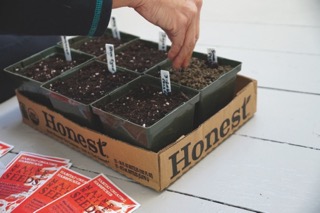
After sowing the seeds, cover with coarse sand rather than potting soil. The sharp grit of the sand keeps the rain from splashing out the seeds and creates a dry surface that prevents rot at the base of the seedling. Different seeds need to be covered different amounts — a good rule of thumb is to sow the seeds as deep as they are thick. Very small seeds are barely covered, if at all. Label the name and date with a durable plastic label. Water with a gentle nozzle until thoroughly wet and place in the shade.
Waiting for germination
In the spring, check on your seed flats (if they are not still buried in snow). You might be surprised by how early some species germinate, which can even be in March when the temperatures are still regularly dipping below freezing. With other species, it may be the heat of summer before the first seedling appears. In wild plants germination can happen over a period of weeks, months, and even years. This is a good strategy for wild plants as offspring are dispersed over time. If there is a drought, period of cold, or heat wave that kills the germinated seedlings, there are still dormant seeds awaiting another chance at life. That said, I regularly experience very good germination with native seeds sown in my nursery.
Collecting seeds from wild plants

A healthy wild plant population usually produces an abundance of seed and can still maintain a viable population with you collecting a few seeds. This is the only sustainable way to acquire wild plants. Digging up root divisions in the wild is not propagation. While it may be okay for you to do this on your own land with common species, it is not a responsible way of getting more native plants into Maine landscapes.
Collecting native seed
If you are interested in collecting your own seed, you need to do some homework before even beginning:
- Make sure you have correctly identified the species. Visit the GoBotany website to help you identify the species and determine if it is a rare species in Maine — in which case you may NOT collect the seed since is illegal to do so.
- If it is not your land, be respectful and ask permission from the landowner before collecting the seed. Also, be aware that it is NOT PERMITTED to collect seeds in national or state parks and often on conservation land.
- Make sure you know how to handle the seed. Research the germination requirements of each species before collecting so that the seed is correctly handled and not wasted. William Cullina’s Growing and Propagating Wildflowers is an excellent reference.
- If you are sure the seed is ripe and it is a healthy population (not one plant), never collect more than 5% of the seed and be sure to sow the seeds you collect.
Let’s all sow some native seed
Every year we humans take up more space, and our native plants are losing ground as a result. It is important to the whole local ecosystem that we provide them a place in our developed landscapes. When you plant a native seed, it grows into a tree or shrub or wildflower that provides food and habitat for many other creatures up and down the food chain, from the pollinating insects, to the birds and other fauna, and even the invisible creatures of the soil.
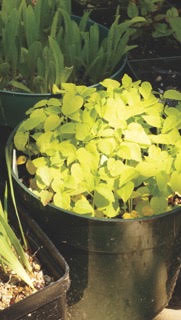
Growing plants from seed is interesting and enjoyable. You will feel proud of your little plants. The Wild Seed Project’s mission is to help more people do this. We offer 60 species of Maine-grown native seeds for sale on our website and which makes it easy to get started with native seed sowing. I also teach workshops on seed collection and sowing. Check out the Wild Seed Project website for propagation and horticultural information, excellent photographs, a monthly blog and plant profile, and upcoming courses and field trips.
Heather McCargo is the Executive Director of The Wild Seed Project, a Maine 501c3 nonprofit organization that sells seeds of wild and uncultivated forms of native plants and educates the public on propagation techniques to encourage increasing native plant populations. We publish an annual magazine Wild Seed. For more information, visit our website at http:/www.wildseedproject.net/.
Staff Favorites: Wildflowers
By Kathy Hopkins, Extension Educator, UMaine Extension Somerset County
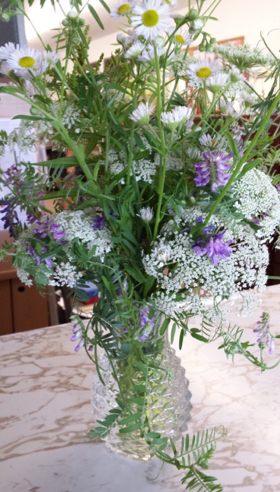
Wildflowers are plants that grow without human cultivation or intervention. Weeds are plants that are out of place. What does one do with plants that are out of place, otherwise known as either “wildflowers” or “weeds”? Usually, they are managed with various forms of annihilation, but I like to keeps some around for their positive qualities. To keep annual wildflowers/weeds from becoming a nuisance, remove the seed heads before the seeds mature and are dropped to make next year’s weeds. Making wildflower arrangements is a great way to keep these plants under control and the cost of the arrangements is minimal. You only need a container, clippers, and possibly some homemade floral preservative.
To create your wildflower bouquet, check your yard for strays that missed your earlier weeding sweeps. If you venture out to forage for wildflowers, make sure you have permission to pick on others’ property. Try and pick flowers early in the morning when they are most turgid. Cut them and immediately place them in warm water while you wait to arrange them. Recut the stems under warm water, if possible, and then immediately arrange them to your taste in your container. If you choose to try using a floral preservative, you can try one of these recipes from the University of Illinois:
3 homemade floral preservatives:
- 2 teaspoonfuls (t.) sugar + 1/2 t. chlorox ) or similar material) + 1/4 t. alum + quart water.
- 2 tablespoonfuls (T.) white vinegar + 2 t. sugar + 1/2 t. chlorox + 1 quart water.
- 1 pint non-diet (must contain sugar) non-cola drink (i.e. Sprite, 7-up, etc.) + 1/2 t. chlorox + 1 pint water.
Great weeds that are long lasting in a vase include the following:
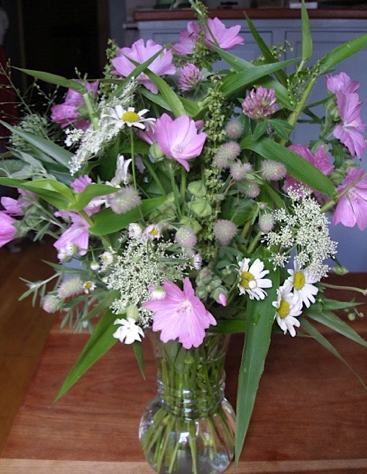
Greenery
- Deer-Tongue Grass (Dichanthelium clandestinum)
- Dock (Rumex species)
Flowers
- Oxeye daisy (Leucanthemum vulgare)
- Daisy Fleabane (Erigeron strigosus)
- Pink clover (Trifolium pratense)
- Queen Anne’s Lace (Daucus carota)
- Rabbit’s foot clover (Trifolium arvense)
- Hairy vetch (Vicia villosa)
For more information on the care of cut flowers read more in Start to Finish: Growing a Cut Flower Garden from the University of Illinois.
Master Gardener Mentors Can Ease the Transition for New Trainees
By Marjorie Peronto, Extension Educator, UMaine Extension Hancock County
None of us needs more stress. But re-entering a classroom with homework and quizzes after decades away from academics is anxiety producing. The Master Gardener Volunteer training, no matter how fabulous and fun we educators try to make it, can be a bit daunting. In Hancock County, we’ve set up an informal Master Gardener Mentoring program for just that reason.
Seasoned MGVs on the Hancock County MG Advisory Committee serve as mentors to new Master Gardener students. The purpose of being a mentor is to provide support, guidance, and a listening ear to new Master Gardener Volunteer trainees. Three to four weeks into the training, each new student receives a phone call, an invitation to connect with a veteran MGV (their pre-selected mentor) for a casual chat. How is the Master Gardener Volunteer training going for you so far? Is it meeting your expectations and needs? Is there any feedback you’d like to give about the training? Concerns you’d like to express? Positive comments? Questions? This opens the door for a relationship to form over the remaining months of the training…or not. Mentors are asked to check in with their mentees at least once a month, answer questions, troubleshoot, and report back to the Advisory Committee and Extension Educator, particularly if there are any issues that need to be addressed. They remain in contact throughout the entire training period and into post-training volunteer activities.
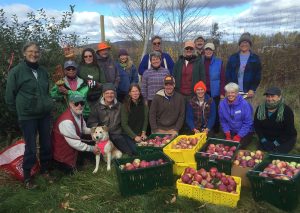
Some students really enjoy having a mentor. Mel, a new MGV student said, “It felt good that there was someone there, and I wasn’t just left hanging to do it on my own.” Mel’s mentor also happened to be a MGV class helper, so they saw each other every week at the training. Liz, another new trainee, “was thrilled, felt comforted by the fact that this was set up for me. It was nice to know I had somebody there.”
Both Mel and Liz became mentors themselves for new students the following year, and this is where their stories diverge. Liz was really looking forward to mentoring a new student. She made many attempts via phone and email to contact her mentee, who did not reply. When she finally reached her person, they had one conversation, where the student said she felt no need to get together or continue with a mentorship, as she was perfectly content working on her own. Sometimes people just don’t need or want a buddy forced on them, and we have to respect that! But Liz was disappointed by the missed opportunity.
Mel and his new MGV protégé Tim were randomly matched based on the proximity of the towns they lived in. They hit it off immediately and wound up volunteering on the same project. Mel says that being a mentor “gives you self-confidence that you can help somebody with a project or gardening issue. You get to meet other people that have the same interests that you do, can develop a relationship with that person that could last a long time.” New MGVs get to work closely with someone who has been through the process. “The coordinator can’t touch everyone, and mentoring gives a personal touch to every student. We are all learning,” says Mel. Mel and Liz would both gladly be a mentor again. If you are a seasoned Master Gardener Volunteer, perhaps this could be your calling as well!
Food & Nutrition:
New “Choice” Salsa Recipe
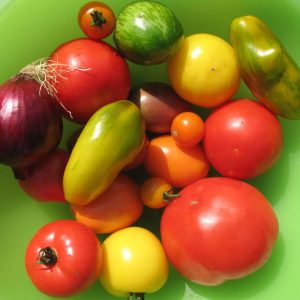 By Kate McCarty, Food Preservation Community Education Assistant, UMaine Extension Cumberland County
By Kate McCarty, Food Preservation Community Education Assistant, UMaine Extension Cumberland County
Making and canning salsa is a great way to use up garden tomatoes and peppers while creating a delicious pantry staple. In the past, home canners have grumbled about available salsa recipes, finding them too restrictive to suit their personal tastes. A new recipe from the National Center for Home Food Preservation aims to change that. It’s called Choice Salsa, and it offers a ratio of ingredients, allowing you to choose how much onions or peppers you add, as well as how spicy you want the salsa to be.
Because salsa is a combination of high-acid (tomatoes) and low-acid (onions, peppers) ingredients, it’s important to follow the quantities listed in this recipe precisely. Any change to the quantity of ingredients, such as vegetables or lemon juice, can result in an unsafe product for long term storage. That said, you can safely substitute sweet peppers for spicy ones or vice-versa. The addition of small amounts of dried spices will not affect the safety of the product either. You can be creative in your salsa-making with the addition of salsa spices, such as cumin, cilantro, and oregano, or the addition of hot peppers for heat.
Salsa made using a tested recipe from a trusted source can be canned using a boiling water bath canner. For more information on canning salsa, read Salsa Recipes for Canning (PDF). To learn more about how to can safely, consider attending a UMaine Extension hands-on food preservation workshop.
Choice Salsa
Adapted from National Center for Home Food Preservation
Ingredients
- 6 cups peeled, cored, seeded, and chopped ripe tomatoes
- 9 cups diced onions and/or peppers of any variety
- 1 ½ cups commercially bottled lemon or lime juice
- 1 tablespoon canning or pickling salt
- 1 tablespoon ground cumin (optional)
- 3 tablespoons dried oregano leaves (optional)
- 1 teaspoon ground black pepper (optional)
Yield: About 6 pint jars
Directions
CAUTION: Wear plastic or rubber gloves and do not touch your face while handling or cutting hot peppers. If you do not wear gloves, wash hands thoroughly with soap and water before touching your face or eyes.
To prepare tomatoes: Dip washed tomatoes in boiling water for 30 to 60 seconds or until the skins split. Submerge immediately in cold water. Peel off loosened skins and remove cores. Remove seeds and chop (¼- to ½-inch pieces).
Combine prepared ingredients in a large pot; add lemon juice, salt, and spices. Bring to a boil over medium heat while stirring. Reduce heat and simmer salsa for an additional 3 minutes, stirring as needed to prevent scorching. Fill the hot salsa into clean, hot jars, leaving 1/2-inch headspace. Wipe rims of jars with a dampened clean paper towel. Apply lids and screw bands until fingertip tight. Process half-pints or pint jars in a boiling water canner for 15 minutes. Let cool, undisturbed, 12 to 24 hours and check for seals.
University of Maine Cooperative Extension’s Maine Home Garden News is designed to equip home gardeners with practical, timely information.
Let us know if you would like to be notified when new issues are posted. To receive e-mail notifications fill out our online form.
For more information or questions, contact Kate Garland at katherine.garland@maine.edu or 1.800.287.1485 (in Maine).
Visit our Archives to see past issues.
Maine Home Garden News was created in response to a continued increase in requests for information on gardening and includes timely and seasonal tips, as well as research-based articles on all aspects of gardening. Articles are written by UMaine Extension specialists, educators, and horticulture professionals, as well as Master Gardener Volunteers from around Maine, with Katherine Garland, UMaine Extension Horticulturalist in Penobscot County, serving as editor.
Information in this publication is provided purely for educational purposes. No responsibility is assumed for any problems associated with the use of products or services mentioned. No endorsement of products or companies is intended, nor is criticism of unnamed products or companies implied.
© 2016
Call 800.287.0274 (in Maine), or 207.581.3188, for information on publications and program offerings from University of Maine Cooperative Extension, or visit extension.umaine.edu.

